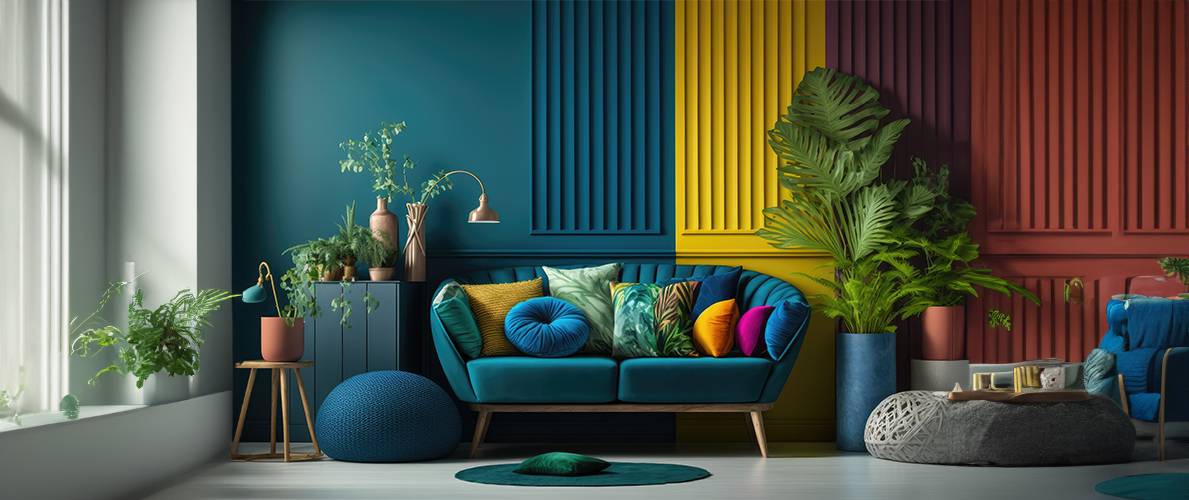Change Your Home With Important Principles of Interior Style and Looks
By understanding the impact of color concept and the value of appearance and patterns, one can develop rooms that are not just aesthetically attractive however also deeply individual. Accomplishing this balance involves even more than plain design; it encompasses a strategic setup and a keen understanding of just how each aspect interacts within an area.
Understanding Color Theory
Color theory is an essential aspect of interior decoration that considerably affects mood, perception, and general aesthetic. Comprehending the principles of shade theory enables designers to produce rooms that resonate emotionally with owners while satisfying functional demands (interior design firms). Shades can be categorized into 3 primary kinds: key, additional, and tertiary. Each group plays an important duty in establishing harmony within a room.
The psychological effect of shades is extensive; cozy hues such as reds and oranges evoke power and heat, while cool tones like blues and eco-friendlies advertise peace and peace. Furthermore, the use of corresponding shades enhances visual rate of interest, developing striking contrasts that can elevate a room's charm.
Neutral colors, on the other hand, work as a functional backdrop, enabling various other layout components to radiate. It is important to take into consideration variables such as illumination and the room's objective when choosing a shade palette, as these can modify the perception of shades throughout the day.
Inevitably, a well-considered color pattern can change an area, promoting a sense of comfort and style that straightens with the citizens' choices. Proficiency of shade theory is, for that reason, an important skill for any indoor designer intending to develop unified and inviting environments.
Attaining Equilibrium in Design
How can developers achieve a feeling of balance in their spaces? Attaining balance in layout is basic to creating unified insides.
Asymmetrical equilibrium, on the other hand, depends on differing elements that still attain a natural look. This method permits even more vibrant and informal setups, supplying interest while keeping balance. By carefully picking varying dimensions, shades, and textures, designers can create a visually compelling space that feels well balanced yet energised.
Radial balance emphasizes a central focal point with elements radiating external. This style is generally seen in circular designs, where furnishings and style create a cohesive border that attracts the eye internal.
Inevitably, attaining balance requires thoughtful consideration of range, percentage, and the partnerships in between components. miami luxury interior design. By masterfully using these equilibrium concepts, developers can change rooms right into settings that really feel both cosmetically pleasing and functionally unified, enhancing the overall experience for occupants
Significance of Spatial Understanding

An eager sense of spatial awareness enables developers to identify prime focus within a space, assisting the visitor's focus to key features while preserving a total feeling of unity. It also aids in the tactical placement of lighting, which can considerably affect the understanding of room and mood. Comprehending spatial relationships enables the designer to provide to the details requirements of occupants, guaranteeing that each area offers its intended function without compromising aesthetics.
Inevitably, spatial recognition is vital for making best use of the possibility of any type of interior room. By thoroughly considering the interaction between measurements, design, and function, developers can create settings that not only meet functional requirements yet likewise stimulate a sense of convenience and charm, enhancing the general living experience.
Incorporating Structure and Patterns
Embracing a varied series of appearances and patterns can considerably boost the visual and responsive appeal of an indoor room. The tactical usage of various products-- such as timber, metal, textile, and stone-- develops depth and passion, making a room really feel extra inviting and vibrant. Combining smooth surfaces with harsh appearances can establish a balance that attracts the eye and involves the detects.
When incorporating patterns, think about both range and repetition. Big patterns can function as prime focus, while smaller, subtle styles can match various other aspects without frustrating the space. Layering patterns, such as pairing flower cushions with striped tosses, includes complexity and a sense of harmony if carried out attentively.
It is also essential to maintain a cohesive shade scheme, making certain that appearances and patterns collaborate rather than compete for attention. By picking a couple of crucial structures and patterns, you can produce a combined aesthetic that reflects your individual design while enhancing the general atmosphere of the room. Inevitably, the mindful consolidation of these elements can change an ordinary area into an innovative atmosphere rich with personality and warmth.
Personalizing Your Room
Producing a space that mirrors your character is vital to attaining a genuinely inviting setting. Personalization in interior style allows see post you to instill your special style and passions into your home, changing it from a mere sanctuary into a refuge that talks with that you are. Begin by choosing a shade combination that resonates with your feelings-- bold tones can stimulate, while soft try here tones offer harmony.
Incorporate art work and decor that mirror your passions, whether it be traveling, nature, or abstract concepts. Presenting personal collections, such as publications, pictures, or mementos, can stimulate treasured memories and create centerpieces within an area. Furthermore, consider tailoring functional items, like upholstered furnishings, to line up with your aesthetic preferences.

Conclusion
In final thought, the improvement of a home with the essential principles of interior decoration and appearance demands a comprehensive understanding of color theory, equilibrium, spatial recognition, structure, and customization. Each component adds considerably to producing an unified and useful living setting - Architecture Firm. By attentively incorporating these concepts, people can boost the aesthetic appeal and psychological vibration of their areas, eventually cultivating a home that mirrors one-of-a-kind identifications while giving convenience and usefulness